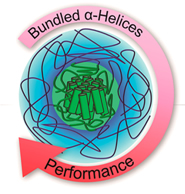Research Highlights
Vol.3, March 2015
Critical core structures for drug-loaded nanocarriers
The use of tiny drug-loaded nanocarriers for the safe, targeted delivery of drugs to designated parts of the body has received much press in recent years. Human trials of nanocarriers targeting pancreatic cancer tumors, for example, have now reached phase three in a number of countries. The nanocarriers themselves are formed from self-assembling polymers, or micelles, created around a core which contains the drug. It is crucial to create micelles that are structurally robust, because they are easily affected by their surroundings en route through the body.
Now, Kazunori Kataoka and co-workers at the University of Tokyo, together with scientists across Japan and Switzerland, have completed a study into micelle cores and how internal core structure affects their ability to deliver drugs effectively in the bodies of mice.
Certain previous designs of micelle have shown defects, dissolving too soon in the body and allowing drug distribution in other organs instead of a concentrated dose reaching the target tumor. The researchers synthesized three types of micelle from a polymeric material called PEG-b-P(Glu), each with different optical activity. Two of the micelle structures formed highly ordered, regular structures in the core when combined with cisplatin, a chemotherapy drug. The third type adopted a more random core structure.
They found that the optically-active micelle with regular bundles of so-called α-helices in its core retained its structure for a prolonged period of time, limiting the risk of dilution. The highly-ordered core also helped control the release of the drug once it reached its target. This was in direct contrast to the micelle with random core structure, which disintegrated rapidly in the bloodstream of the mice.
The team believe that the careful, tailored assembly of micelle cores, as well as considered design of the surrounding protective outer shell, will help improve the efficacy of nanocarriers.
Reference and affiliations
Yuki Mochida1, Horacio Cabral1, Yutaka Miura2, Francesco Albertini3, Shigeto Fukushima4, Kensuke Osada1,5, Nobuhiro Nishiyama,6,* and Kazunori Kataoka1,2,4,*. Bundled Assembly of Helical Nanostructures in Polymeric Micelles Loaded with Platinum Drugs Enhancing Therapeutic Efficiency against Pancreatic Tumor. ACS Nano 8 (7) 2014
doi: 10.1021/nn500498t
- Department of Bioengineering, Graduate School of Engineering, The University of Tokyo, 7-3-1 Hongo, Bunkyo-ku, Tokyo 113-8656, Japan
- Division of Clinical Biotechnology, Center for Disease Biology and Integrative Medicine, Graduate School of Medicine, The University of Tokyo, 7-3-1 Hongo, Bunkyo-ku, Tokyo113-0033, Japan
- Department of Materials, Swiss Federal Institute of Technology Zürich, Wolfgang-Pauli-Strasse 10, CH-8093 Zürich, Switzerland
- Department of Materials Engineering, Graduate School of Engineering, The University of Tokyo, 7-3-1 Hongo, Bunkyo-ku, Tokyo 113-8656, Japan,
- Japan Science and Technology Agency, PRESTO, 4-1-8 Honcho, Kawaguchi, Saitama 332-0012, Japan, and
- Polymer Chemistry Division, Chemical Resources Laboratory, Tokyo Institute of Technology, R1-11, 4259 Nagatsuta, Midori-ku, Yokohama 226-8503, Japan
*corresponding authors, e-mail address:kataoka@bmw.t.u-tokyo.ac.jp ornishiyama@res.titech.ac.jp
Figure:







